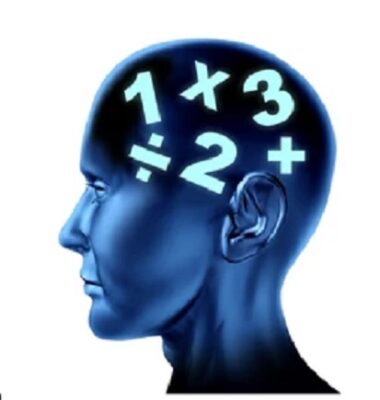If there’s a field that screams logic to me, it’s math. So I was surprised to learn that intuition and the subconscious mind propelled many of the greatest mathematicians to their discoveries.

Source: Shutterstock
In his book, The Psychology of Invention in the Mathematical Field (1944), French mathematician Jacques Hadamard (1865-1963) says sudden flashes of insight provide breakthroughs. Also, that some mathematicians are mostly logical in their thinking, while others are mostly intuitive.
3 Processes of the Inventive Mind
Hadamard came to this conclusion by observing his own mental workings, reports from other highly accomplished mathematicians, psychologists’ investigations and a famous lecture French polymath Henri Poincaré (1854-1912) gave at Société de Psychologie in Paris in 1937. In that address, Poincaré shared his creative breakthrough experiences. He talked about how his mind works and generalized the process into three stages: 1) preparation, 2) incubation, and 3) illumination. Hadamard agrees, but adds verifying and “precising” after illumination.
Not all inventive minds work alike, Hadamard says. But there’s a basic process, with some variations. It doesn’t just apply to mathematical geniuses either. It’s common in other sciences, literature, arts and technology. It even shows up in ordinary life for most of us, if in more mundane ways.
Preparing the Subconscious to Invent
The first stage, preparation, begins with intense, conscious work. Whatever the question or problem to be solved, the scientist or seeker examines theories and facts, turns it over and over in their mind, asks “what if” and tries to find an answer or solution. There may be repeated failures. It’s conscious, deliberate, informed mental work. Eventually, the person gets stuck or feels like there is no answer.
Incubating Inventive Ideas & Solutions
At that point, they put the question and the struggle out of their mind and go do something completely different. Take a walk, or a vacation, or go to a party. Maybe take up a different question. Whatever. But nothing to do with the problem they’re stuck on. This is the incubation stage. It seems like the work has stopped. Maybe even died. But Hadamard says the conscious effort has triggered the unconscious to take action and shaped its direction. There’s something going on in our depths. We’re just not aware of it. Incubation may last a day, a week, months or much longer.
Eureka! Illumination Shows the Answer
Incubation breaks when insight hits. That’s the third stage, illumination. The insight is brief, sudden and immediately certain. Hadamard experienced this when a noise woke him abruptly from a dream during an emotionally intense time in his life. The moment he woke, the solution appeared. He described the experience as unforgettable and the solution was in a different direction than any he’d tried before.
In his lecture, Poincaré said he spent time trying to prove that fuchsian functions couldn’t exist. Then, during a sleepless night bolstered by black coffee, he asked what properties these must have if they exist. Ideas flooded his mind. He developed one class of these functions then got stuck. So he put the math aside and went traveling. As he stepped onto a bus while talking with a friend, an idea about fuchsian groups came to him in a flash, momentary and certain. It was so fleeting that the conversation never faltered. He intended to verify the insight when he returned home.
Invention & Discovery Require the Whole Mind
How does that insight emerge? Hadamard considers freshness, the idea that the mind gets a break and is then able to re-start. He also considers the “forgetting hypothesis.” That the mind has time to forget all of its wrong turns and frustration and can start over. He rejects both ideas.
Instead, Hadamard and Poincaré think the conscious and unconscious mind is working in tandem. Invention and discovery occur by combining ideas. There are many combinations—most of them uninteresting or useless for the problem at hand— that must be sorted. The sorting process takes place in the unconscious. After it’s been given direction, or educated—as Poincaré called it, by the conscious mind’s work.
The Unconscious Mind Taps Will & Emotion
The unconscious includes many layers, some that are very deep. Much of its processing we’ll never be aware of, and so never know all of the combinations it tossed around. Those that leap into the conscious mind, they say, are the combinations or ideas that profoundly affect our emotional sensibility—in the case of mathematicians, beauty, harmony—and therefore most likely to be useful. Hadamard says an affective element is an essential part of every discovery or invention. He calls “the will of finding” an affect or esthetic.
The Conscious Mind Verifies
After illumination, or inspiration, the conscious mind goes to work again. It must verify in some way that the insight is correct, despite the immediate sense of certainty. Usually this involves a working out of the solution, drawing out its details and methods and making it more precise. In the case of writing or art, this may mean finding just the right word or image or fleshing out the insight.
Intuitive Invention Process Varies
Some part of the process can vary between individuals. For instance, for Hermann von Hemholtz, a physicist and physician of Hadamard’s time, “happy ideas”, which is what he called illumination, don’t happen when the mind is fatigued. For him, there was a very precise time that his mind needed to refresh. Afterward, these happy ideas may show up. The process can even vary in some ways for the same person under different circumstances or at different times.
What is Hadamard’s example of how this works with even mundane things? Ever tried to recall a name or place and you just can’t? After you stop trying, forget about it and go on with your day, that deeper part of you coughs up the answer—maybe when you’re stepping onto a bus.
